ASUS ProArt StudioBook 17 H700GV review (Xeon E-2276M, RTX 2060)
StudioBooks are a newer lineup of mobile workstation notebooks from Asus, and we’ve already covered some of the available options here on the site, such as the StudioBook Pro 17 and the beastly StudioBook Pro X.
However, aside from the top and mid-range models built on Intel Core/Xeon processors and Nvidia RTX Quadro graphics, Asus also offer a standard StudioBook subseries built with consumer-grade RTX GeForce graphics. The 17-inch variant in this lineup is the ProArt StudioBook 17 H700GV that we’re going to talk about in this review.
Aside from the graphics, the StudioBook 17 H700 and the StudioBook Pro 17 W700 are identical in every way. Oversimplifying things, performance-wise, the GeForce RTX 2060 it bundles is a tier-match for the RTX Quadro 3000 chip in the Pro models. However, while the GeForce chip gets gaming optimized drivers, the Quadro is optimized for productivity software and reliability. The differences between them are small, though, and even pricing seems to be nearly identical in most regions.
With that in mind, this review will primarily shed light on the performance difference between the two models. We’ll also touch on all the other important aspects of this ProArt StudioBook 17, but we’ll mostly refer to our previous review for in-depth impressions on these.
Specs as reviewed – ASUS ProArt StudioBook Pro 17 H700
ASUS ProArt StudioBook 17 H700GV
Display
17-inch, 1920 x 1200 px IPS 60 Hz, 16:10, non-touch, matte, Hannstar 170PUW1-A00 panel
Processor
Intel Coffee Lake Xeon E-2276M, six-core with HyperThreading
Video
Intel HD 630 + Nvidia GeForce RTX 2060 6 GB GDDR6 80W (Nvidia 442.19), with Optimus
Memory
32 GB DDR4 2666 MHz (2x DIMMs)
Storage
2x M.2 PCI x4 slots, with CPU-attached RAID 0/1 support (1x 1 TB Intel 760P SSDPEKKW010T8 and 1x 1 TB Samsung PM981 MZVLB1T0HALR-00000)
Connectivity
Wireless 6 (Intel AX200) 2×2, Bluetooth 5.0, Ethernet via USB dongle
Ports
3 x USB-A 3.1 gen2, 1x USB-C with Thunderbolt 3, HDMI 2.0, SD 4.0/UHS-II card reader, mic/headphone, Security Lock
Battery
57 Wh, 230 W charger
Size
382 mm or 15.03” (w) x 265 mm or 10.43” (d) x 28.2 – 32.1 mm or 1.11” -1.26″ (h)
Weight
5.4 lbs (2.44 kg), 1.67 lbs (.76 kg ) for charger and cables, US version
Extras
white backlit keyboard, 720p webcam, stereo speakers, finger sensor
Update: Here’s our coverage of the updated 2023 Asus ProArt StudioBook Pro 16 3D OLED lineup.
This is a higher-tier configuration of the ProArt StudioBook H700, but Asus offers the series in a few different options, with the Xeon E-2276M or the Core i7-9750H processor, as well as various amounts of storage and RAM. There’s no other GPU choice aside from the RTX 2060 80W.
Furthermore, the StudioBook series is available in either a 15 or 17-inch version. I’ve added a pic of the two side by side below. The 15-inch model is pretty much a rebadged ROG Zephyrus M with a wide-gamut 4K display, while the 17-incher gets the FHD+ screen and a few extra features.
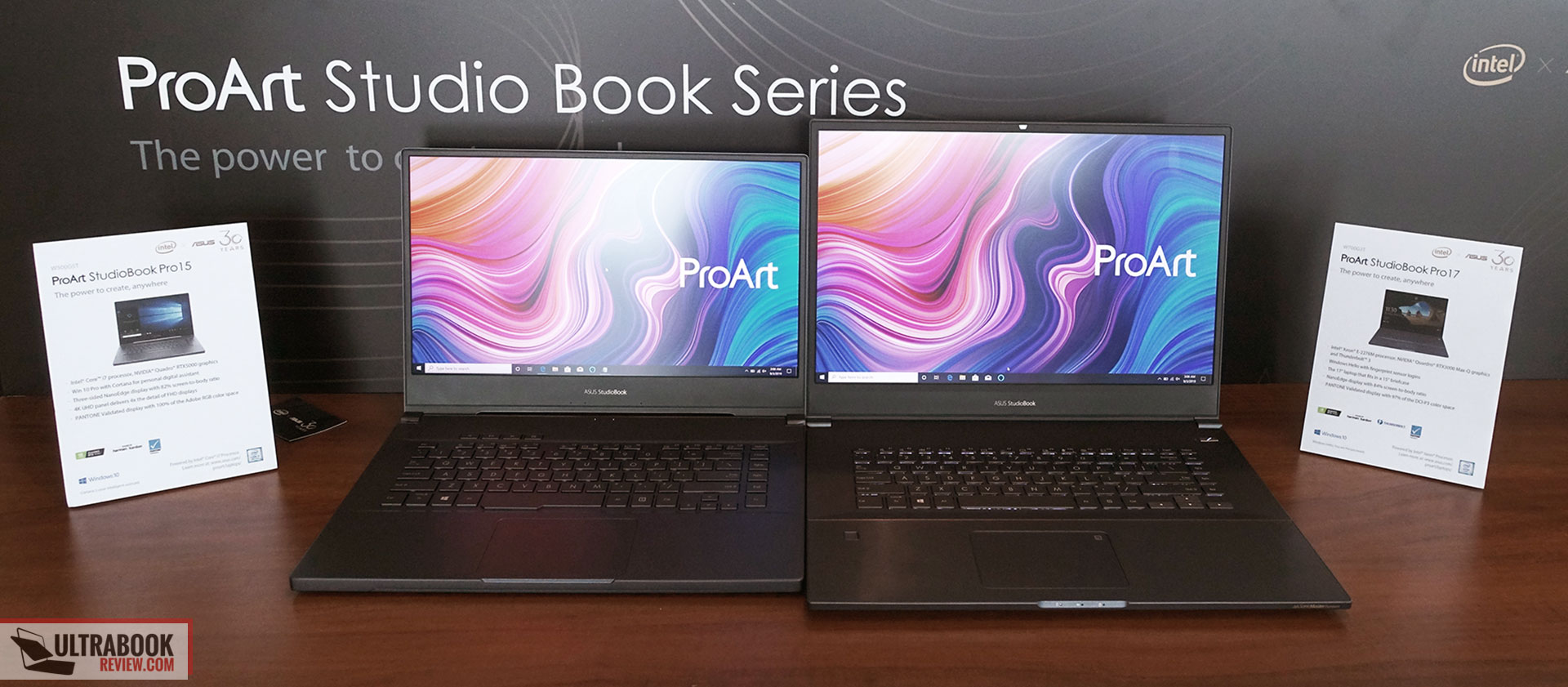
Design and construction
You’ll find our in-depth impressions of this laptop’s design, build-quality and practicality in our detailed review of the ProArt StudioBook Pro, with whom this shares all characteristics.
In few words, though, it’s well built and cleanly crafted, with magnesium and aluminum materials used for the construction. It also meets MIL-STD 810G standards for durability and reliability.
On the practical side, the StudioBook 17 is fairly light, but also rather large for a 2020 17-inch notebook, and you can tell this from the hefty chin beneath the display. Ergonomically, I actually appreciate this aspect, as it allows for plenty of space inside from the components and thermal module, and also pushes the screen upwards. The screen can also lie flat to 180 degrees, and Asus made sure not to neglect connectivity, including everything you’ll want here, except for a LAN port (wired Internet is possible with the USB-LAN adapter included in the pack).
Keyboard and trackpad
The keyboard is borrowed from the ROG Zephyrus models and is a centered design, without a NumPad section, which some of you might want in a productivity notebook such as this one.
Asus compensates for it by including a virtual Numeric pad into the clickpad, but it’s not the same. The clickpad is fairly small, but it’s made of glass and feels nice to the touch, is responsive and accurate. I found the physical clicks rather clunky, and the surfaced still rattled with touches, much like on the StudioBook Pro we’ve reviewed a while ago.
Back to the keyboard, it’s a fairly shallow implementation with limited travel, but it’s just what I enjoy, so I was able to type quickly and fairly accurately. It requires focus, though, as the feedback will otherwise penalize straying fingers, hence the inconsistent results in our tests, illustrated in one of the pictures below.
This keyboard is also backlit, with bright LEDs and three intensity levels to choose from. The implementation includes a CapsLock indicator, and the light switches on when swiping fingers over the clickpad’s surface. The light still creeps from under some of the keys, but at least the illumination is fairly homogenous on this sample, unlike on the previous one we’ve tested. This is a retail unit, though, while the StudioBook Pro 17 we tested in the past was pre-production.
Screen
The screen is definitely one of this laptop’s main selling points. It’s matte and uses the same 16:10 1920 x 1200 px panel we’ve previously seen on the StudioBook Pro and the Pro X.
It’s made by Hannstar and offers fine brightness and contrast levels, as well as wide-gamut color coverage and pre-calibration with a Pantone certification.
The taller 16:10 aspect ratio allows for an increased work-space, an excellent quirk for a productivity notebook and something few other 17-inch laptops offer these days. At the same time, though, competing workstations can be specced with UHD screens with increased brightness and HDR support, while the StudioBooks are stuck with this single panel choice.
Anyway, here’s what we got on our sample with a Sypder4 sensor.
- Panel HardwareID: Hannstar HSD1702 (170PUW1-A00);
- Coverage: 99.7% sRGB, 85.7% AdobeRGB, 98.5% DCI P3;
- Measured gamma: 2.28;
- Max brightness in the middle of the screen: 285 cd/m2 on power;
- Contrast at max brightness: 587:1;
- White point: 6700 K;
- Black on max brightness: 0.48 cd/m2;
- PWM: N/A.

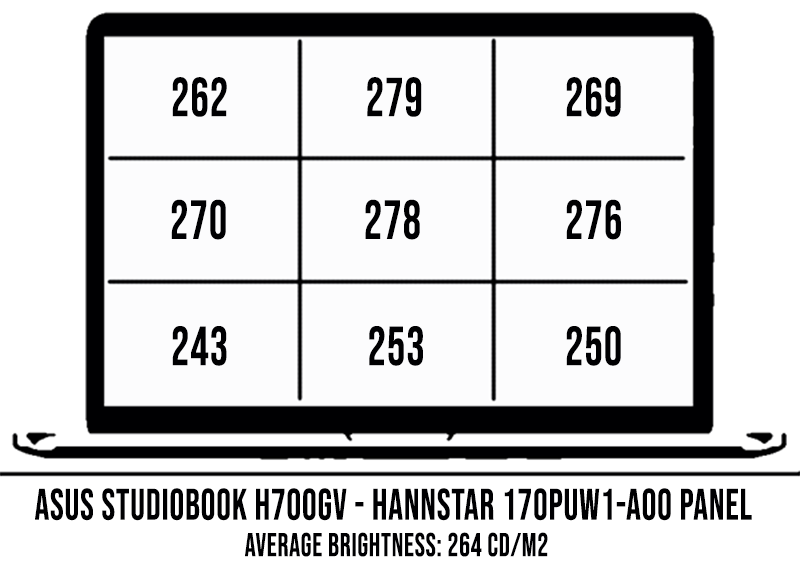
The panel came well-calibrated out of the box, with just a slight gamma and white-point imbalance. That can be addressed with this calibrated profile, which also leads to excellent DeltaE 2000 color uniformity.
Our sample also came up a little dimmer than the same panel in the Pro and Pro X and with the same high black levels, which suggests there’s a degree of variation between these panels. We also noticed some light bleeding on dark backgrounds, especially along the lower lip.
Finally, I’ll also add that this is a 60Hz panel with only average response times, so not an ideal choice for gaming.
Hardware, performance and upgrades
Our test model is a top-tier configuration of the Asus ProArt StudioBook 17 H700GV, with the Intel Xeon Xeon E-2276M processor, 32 GB of DRR4 2666 MHz RAM, two NVMe SSDs in Raid 0, as well as the Nvidia GeForce RTX 2069 80W graphics chip.
This is a retail unit identical to those available in stores and came from Asus for the purpose of this review. All the tests were run on BIOS 300, Nvidia 442.19 graphics drivers and the MyAsus version 2.2.10 app, the latest available at the time of the article.
The Xeon E-2276M is a six-core processor with HyperThreading, an optimized and slightly higher-clocked version of the popular Core i7-9750H, which is also an option for this laptop. The RTX 2060 graphics chip is the standard 80W implementation, and not the faster 90W model you’ll get with many of the mid-range gaming laptops of this generation.
The platform can take up to 64 GB of RAM, with optional ECC memory support on the Xeon configurations. It can also take two PCIe x4 drives, and our configuration gets two 1 TB units, a fast Samsung PM981 and a mid-tier Intel 760p. They’re linked in RAID 0 though, which leads to the excellent benchmarks scores above, and which also affects some of our other test results.
The CPU and GPU are soldered on the motherboard, but the RAM and storage are accessible. For that, you’ll have to remove the back-panel, hold in place by a few Philips screws, all visible around the sides.
Of course, this laptop can easily handle everyday chores like browsing, Netflix, etc. Its portable form-factor might make it an appealing all-rounder, and while it can certainly handle unplugged use running quietly and cooly, don’t forget this gets a small battery, so won’t last for long on a charge. More about this in a further section.
But then this is also a performance notebook, so the next part touches on the system’s performance in taxing chores.
First, we test the CPU’s performance in demanding loads by running Cinebench R15 for 10+ times in a loop, with 2-3 sec delay between each run, which simulates a 100% load on all the cores. Asus offers two fan/performance modes in the MyAsus app that comes bundled with the laptop, Auto and Turbo.
The Auto profile keeps fan-noise within decent limits and limits the CPU’s power at 55 W, while Turbo raises that limit to 62 W. As shown by the graphs below, though, the performance drops after the initial runs in both cases.
Undervolting, with either XTU or Throttlestop, mostly addresses this aspect. Our sample ran stably at -125 mV, and while a 60W Power Limit is also the limiting factor in this case, the CPU is able to run at higher clocks for the entire duration of the test, and the limitation kicks in later, after 7-8 Cinebench runs.
Finally, we run the same test with the laptop unplugged, with inconsistent results caused by a big variation in TDP and frequencies, as illustrated in one of the pictures below.
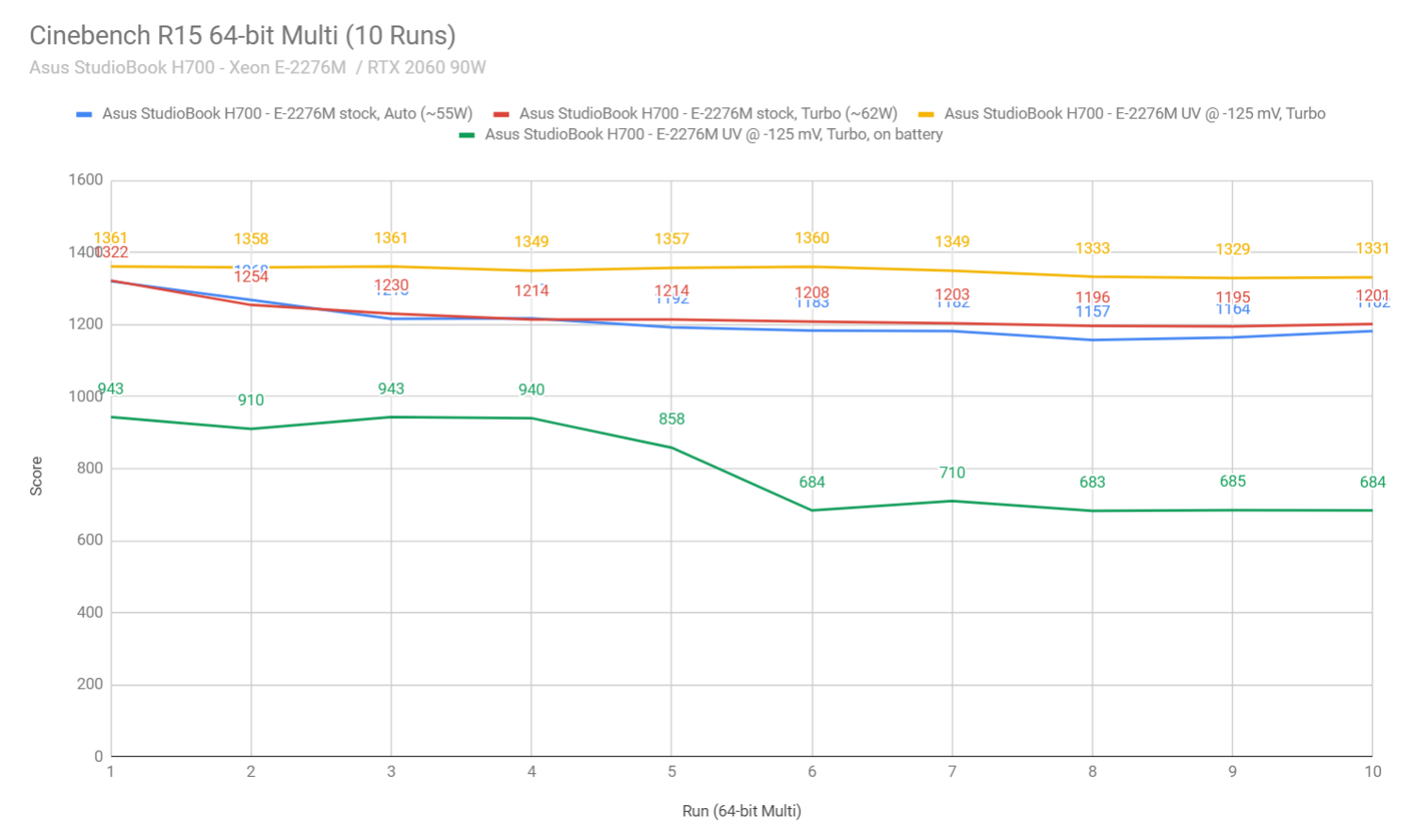
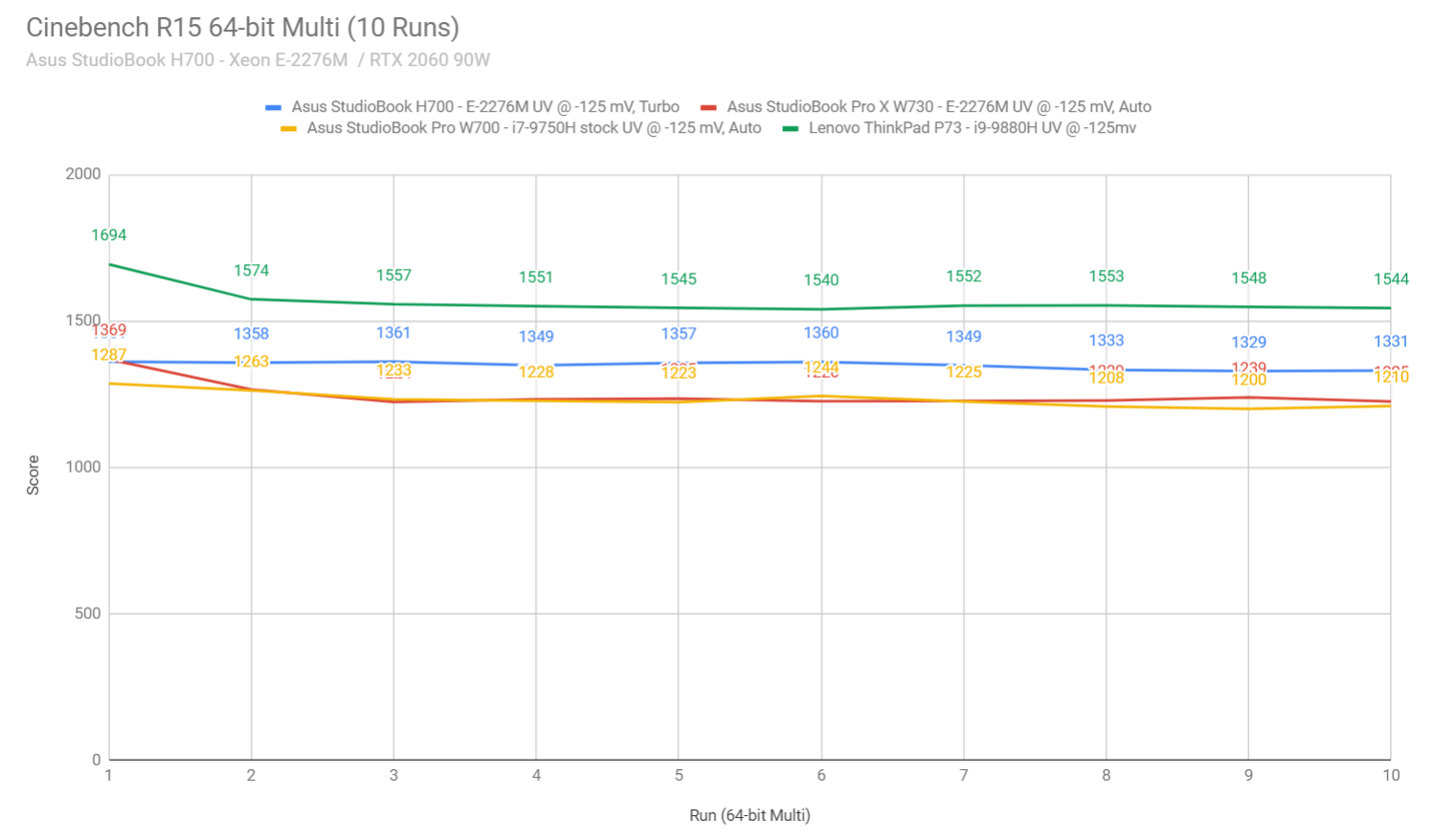
The next tests put both the CPU and GPU to work at the same time.
The sample passed the 3DMark Stress Test with flying colors on both the stock Turbo and the undervolted Turbo profiles, which suggests constant performance over time. Then, we moved on to our Luxmark CPU+GPU stress test. In this case, the CPU stabilizes at 45 W and the GPU runs constantly at its designed 80W TDP, with fine temperatures for such a demanding load: 84 C on the CPU and 79 C on the GPU.
Next, we’ve run the entire suite of tests and benchmarks, on the Turbo profile with stock settings.
- 3DMark 11: 17419 (Graphics – 19198, Physics – 13906);
- 3DMark 13 – Fire Strike: 13744 (Graphics – 14874, Physics – 18103);
- 3DMark 13 – Time Spy: 5900 (Graphics – 5730, CPU – 7096);
- 3DMark 13 – Port Royal: 3268;
- Uniengine Superposition – 1080p Extreme: 3458;
- GeekBench 4.4.2 64-bit: Single-Core: 5624, Multi-core: 25135;
- GeekBench 5.0.1 64-bit: Single-Core: 1261, Multi-core: 6381;
- CineBench R15 (best run): CPU 1323 cb, CPU Single Core 193 cb;
- CineBench R20 (best run): CPU 2874 cb;
- x264 HD Benchmark 4.0 32-bit: Pass 1 – 216.84 fps, Pass 2 – 78.82 fps;
- x265 HD Benchmark 64-bit: 50.06 s.
Then we reran some of them on the -100 mV undervolted profile. We lowered our undervolt to -100 mV for the rest of our tests in order to prevent any sort of stability issues that won’t be acceptable on a workstation:
- 3DMark 11: 17526 (Graphics – 19371, Physics – 13886);
- 3DMark 13 – Fire Strike: 13834 (Graphics – 14952, Physics – 18112);
- 3DMark 13 – Time Spy: 5939 (Graphics – 5748, CPU – 7325);
- 3DMark 13 – Port Royal: 3262;
- Uniengine Superposition – 1080p Extreme: 3381;
- PassMark: Rating: 6508, CPU mark: 16014, 3D Graphics Mark: 10742;
- PCMark 10: 5304 (Essentials – 10164 , Productivity – 8085 , Digital Content Creation – 4928);
- GeekBench 4.4.2 64-bit: Single-Core: 5599, Multi-core: 25553;
- GeekBench 5.0.1 64-bit: Single-Core: 1234, Multi-core: 6497;
- CineBench R15 (best run): CPU 1363 cb, CPU Single Core 191 cb;
- CineBench R20 (best run): CPU 3170 cb, CPU Single Core 461 cb;
- x264 HD Benchmark 4.0 32-bit: Pass 1 – 220.88 fps, Pass 2 – 83.02 fps;
- x265 HD Benchmark 64-bit: 47.78 s.
We also ran some Workstation related loads, on the same -100 mV undervolted Turbo profile:
- Blender 2.82 – BMW Car scene- CPU Compute: Time – 5:08.68 (stock), 4:35.59 (UV);
- Blender 2.82 – BMW Car scene- GPU Compute (CUDA): Not supported;
- Blender 2.82 – Classroom scene – CPU Compute: Time – 16:47.08 (stock), 15.04.48 (UV);
- Blender 2.82 – Classroom scene – GPU Compute (CUDA): Not supported;
- Luxmark 3.1 – Luxball HDR – OpenCL CPUs + GPUs score: 25689 (UV);
- SPECviewerf 13 – 3DSMax: 131.69 (UV);
- SPECviewerf 13 – Catia: 92.39 (UV);
- SPECviewerf 13 – Creo: 128.68 (UV);
- SPECviewerf 13 – Energy: 15.05 (UV);
- SPECviewerf 13 – Maya: 159.94 (UV);
- SPECviewerf 13 – Medical: 39.75 (UV);
- SPECviewerf 13 – Showcase: 75.55 (UV);
- SPECviewerf 13 – SNX: 14.68 (UV);
- SPECviewerf 13 – SW: 68.00 (UV).
It’s worth noting that some of the Blender CUDA renders are not compatible with the GeForce RTX chip, that’s why a Quadro RTX 3000 would be preferred for this kind of loads.
The RTX 2060 should have an edge in games, and we tested a few titles at the screen’s native FHD+ resolution.
FHD+ UV
Far Cry 5 (DX 11, Ultra Preset, SMAA)
79 fps
Middle Earth: Shadow of Mordor (DX 11, Ultra Preset)
109 fps
Rise of Tomb Raider (DX 12, Very High Preset, FXAA)
60 fps
Shadow of Tomb Raider (DX 12, Highest Preset, TAA)
65 fps
The Witcher 3: Wild Hunt (DX 11, Ultra Preset, Hairworks On 4)
60–92 fps
- Battlefield V, The Witcher 3 – recorded with Fraps/in-game FPS counter in campaign mode;
- Far Cry 5, Middle Earth, Tomb Raider games – recorded with the included Benchmark utilities.
We haven’t reviewed the RTX Quadro 3000 version of the StudioBook Pro W700 for an apples to apples comparison, and in fact, we’ve only tested a single implementation of this Quadro chip. Based on those scores, the RTX 2060 delivers better fps results in games, but in reality, the two chips are nearly identical, with only software setting them apart, so the differences could be smaller with better-optimized drivers in the future.
The HWinfo logs below show the CPU and GPU speeds and temperatures in Farcry 5, Shadow of Mordor and Witcher 3 on the stock Turbo Profile.
And here’s how the undervolt affects the performance and especially the temperatures, both on the CPU and the GPU.
Finally, we ran Witcher 3 with the laptop unplugged, but the experience lacked in consistency, with the same power and frequency variations we’ve encountered in the Luxmark stress test. That means gaming or other complex CPU+GPU loads are too tough for this laptop to handle while running on battery.
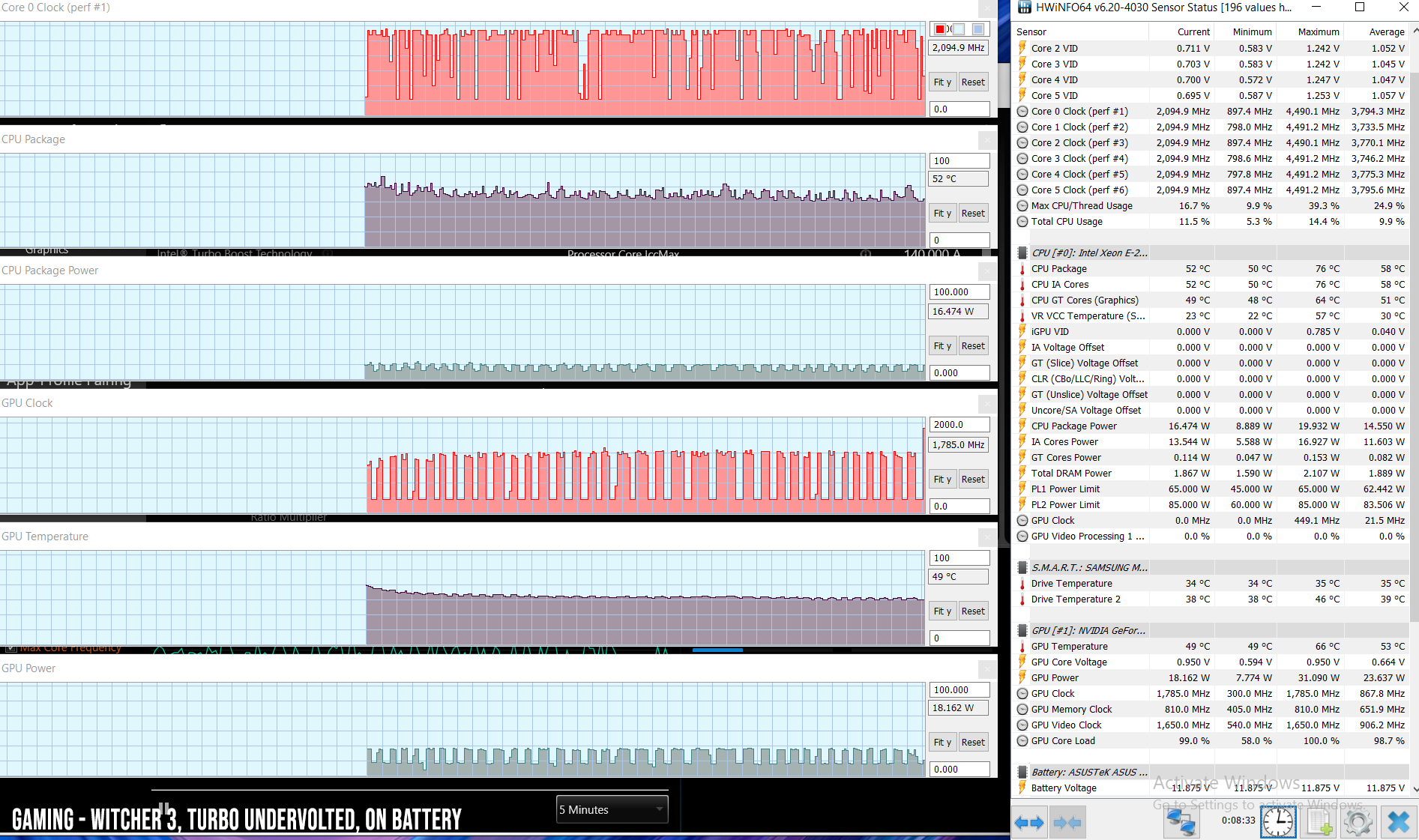
Noise, Heat, Connectivity, speakers, and others
The StudioBook 17 H700GV gets a complex thermal module, with two fans and multiple heat-pipes and heat-plates spread over the CPU/GPU. There’s no plate on top of the VRMs at the top, which is a little surprising.
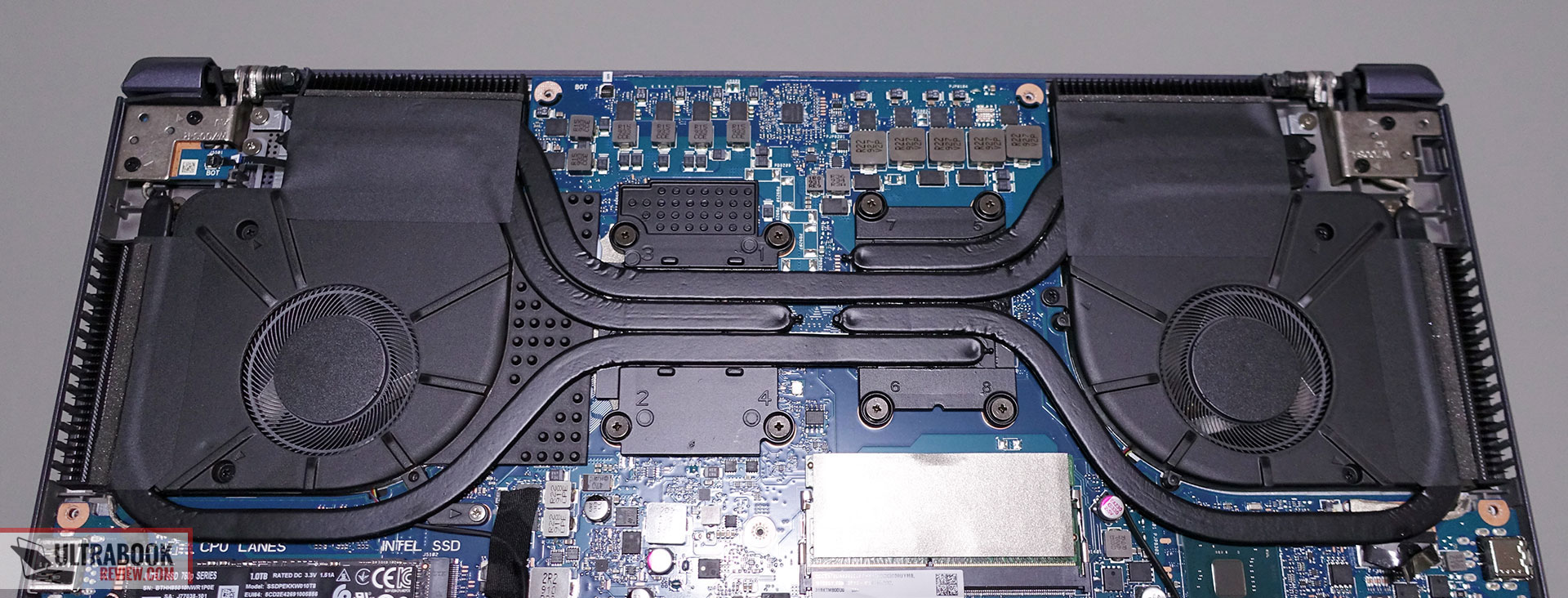
This cooling design is capable of taming the Xeon/RTX 2060 configuration, as explained above. However, the CPU and GPU reach high temperatures in demanding loads on this configuration, and a fair bit of heat is transferred onto the exterior chassis as well. However, only the bottom part goes past 50 degrees Celsius, around the thermal module, and raising the laptop from the desk does help lower those temperatures.
The fans run fairly quietly even on the Turbo profile. With games and stress tests, they ramp up to about 43-44 dB at head-level. They also remain active with daily use, but at 33-35 dB are hardly audible in a normal room. On this unit I no longer observed the high-pitch roar that I noticed on the StudioBook Pro 17 sample, and also haven’t noticed any coil whine or other electrical noises either.
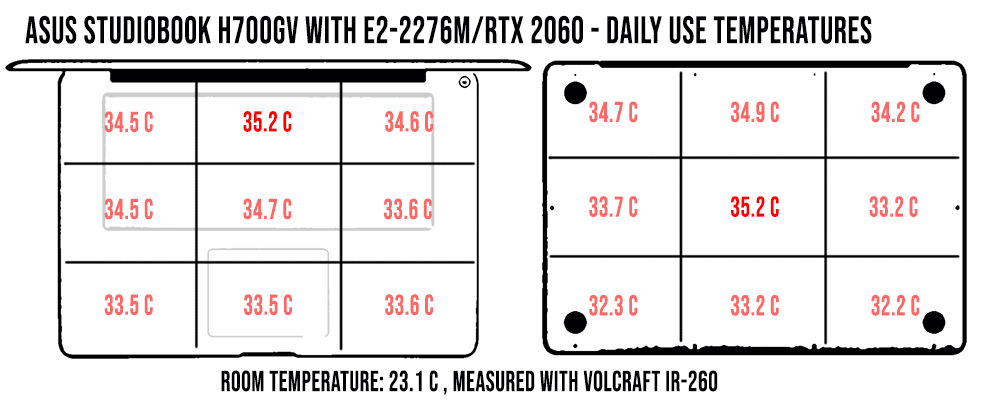
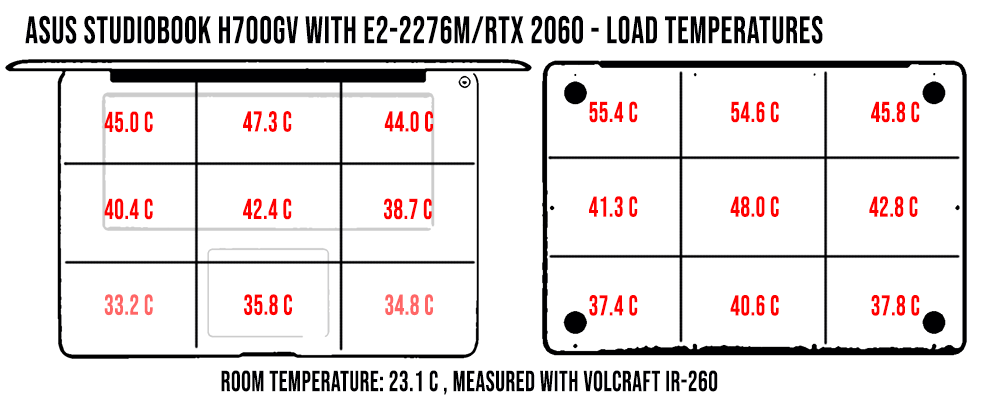
*Daily Use – streaming Netflix on EDGE for 30 minutes, on Auto profile (fans ~ 33-35 dB)
*Load – playing Far Cry 5 for 30 minutes, on Turbo UV profile (fans ~ 43-44 dB)
For connectivity, the StudioBook Pro gets Intel’s latest Wifi 6 AX200 chip in a 2×2 implementation. It performed flawlessly with our setup, both near the router and at 30+ feet away, with obstacles in between. Asus also includes an USB-to-Lan adapter in the pack, in case you need a wired Internet connection.
A set of speakers is placed on the laptop’s bottom front edge, with averagely sized chambers. The sound comes out alright, without any distortions, average volumes (up to 75-76 dB at head level) and fair quality. It’s still rather lacking in the lows, but the bass is not awful and noticeable from around 100 Hz. You will, however, feel the vibrations into the arm-rest at volumes above 50%, and that can get annoying.
Also, make sure not to cover these speakers while using the computer on the lap, it can take a further toll on the sound quality.
Lastly, the StudioBook gets an HD webcam at the top of the screen, flanked by microphones. It’s pretty much a standard laptop camera, only good enough for occasional use.
Battery life
Asus offers the StudioBook 17 H700 with a small 57 Wh battery, which is this laptop’s major culprit. You do get Optimus, but there’s no way past its small size. Furthermore, for some reason, this sample also ran less efficiently than the Core i7/ Quadro T2000 variant reviewed in the StudioBook Pro.
Here’s what we got on our review unit, with the screen’s brightness set at around 120 nits (~60 brightness).
- 15 W (~4- h of use) – text editing in Google Drive, Better Battery Mode, screen at 60%, Wi-Fi ON;
- 12.8 W (~4 h 25 min of use) – 1080p fullscreen video on Youtube in Edge, Better Battery Mode, screen at 60%, Wi-Fi ON;
- 10.5 W (~5+ h of use) – Netflix fullscreen in Edge, Better Battery Mode, screen at 60%, Wi-Fi ON;
- 22 W (~3 h of use) – browsing in Edge, Better Performance Mode, screen at 60%, Wi-Fi ON;
- 55 W (~1 h of use) – Luxmark, Max Performance Mode, screen at 60%, Wi-Fi ON.
Asus bundles this configuration with a 230 W power-brick. It weighs about 760 grams, and that’s important to keep in mind, as you’ll pretty much have to bring the charger along most of the time. I’m not sure whether USB-C charging is supported, I don’t have the right charger around to try it out.
Price and availability
The ProArt StudioBook 17 H700GV is available at the time of this article and starts at $1999 for the i7-9750H/16 GB RAM/1 TB SSD configuration. That’s in fact identical to the i7-9750H/RTX Quadro 3000 version of the StudioBook Pro W700, which I find surprising, as I would have expected the GeForce version to have a more aggressive pricing scheme on its side.
Outside the US Asus seems to only offer higher-tier, and thus more expensive, configurations of the StudioBook Pro, which leaves the standard StudioBook as the single more affordable variant.
Follow this link for more details and updated configurations/prices.
Final thoughts
With that in mind, if both the StudioBook H700GV and the StudioBook Pro W700G3T are available in your region for the same price, I see very little reason to chose the former over the latter. Yes, the RTX 2060 is perhaps slightly faster in games, but then this is not a gaming laptop to begin with, as it only comes with a 60 Hz screen. Hence, if gaming is what you’re after, you’ll find better value, features and performance elsewhere.
These ProArt StudioBooks primarily shine as work computers, and the RTX Quadro 3000 chip in the Pro versions is better suited for Blender, computations and image/video rendering, hence the Pros are the ones to get. Furthermore, if a portable construction is not a must, the StudioBook Pro X is also worth more than a look, with improvements in performance, thermals, and features.
In all fairness, pricing and configurations might vary in your region, so the non-Pro version might make sense with a discount over a matching RTX Quadro 3000 Pro model.
Nonetheless, both these 17 -inch StudioBooks are solid efforts from Asus in this niche of mobile workstations. They’re compact and lightweight for their class, nicely crafted, pack a productivity-oriented 16:10 display and check the right boxes when it comes to performance, thermals and noise levels. On the other hand, the short battery life and poor performance while unplugged are culprits you’ll have to accept.
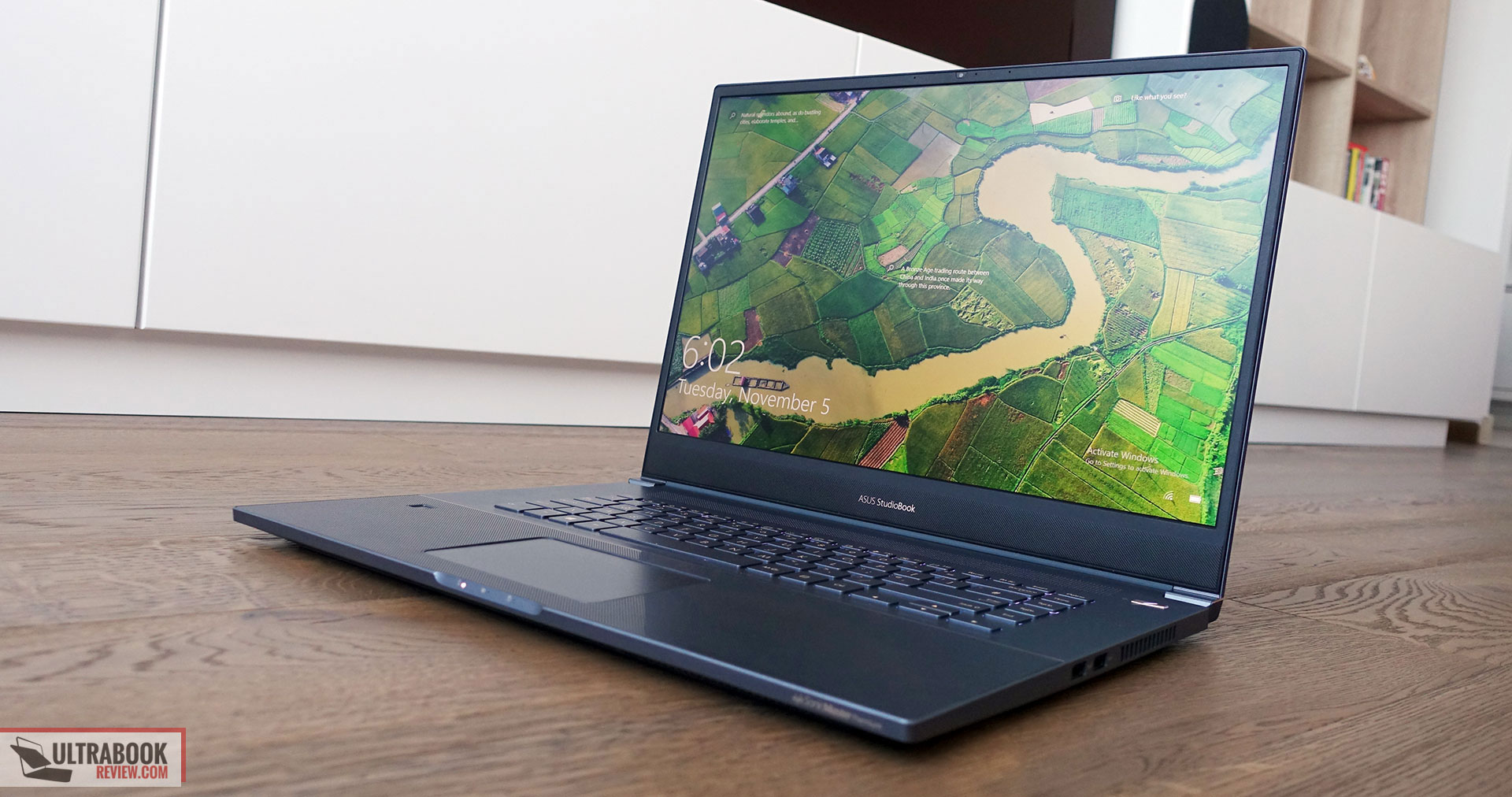
Disclaimer: Our content is reader-supported. If you buy through some of the links on our site, we may earn a commission.
Navigation: Ultrabookreview.com » 15.6 inch or larger
Our content is reader-supported. If you buy through some of the links on our site, we may earn a commission. Terms


Review by: Andrei Girbea
Andrei Girbea, Editor-in-Chief. I’ve a Bachelor’s in Computer Engineering and I’ve been covering mobile technology since the 2000s. You’ll mostly find reviews and thorough guides written by me here on the site, as well as some occasional first-impression articles.
. I’ve a Bachelor’s in Computer Engineering and I’ve been covering mobile technology since the 2000s. You’ll mostly find reviews and thorough guides written by me here on the site, as well as some occasional first-impression articles.






